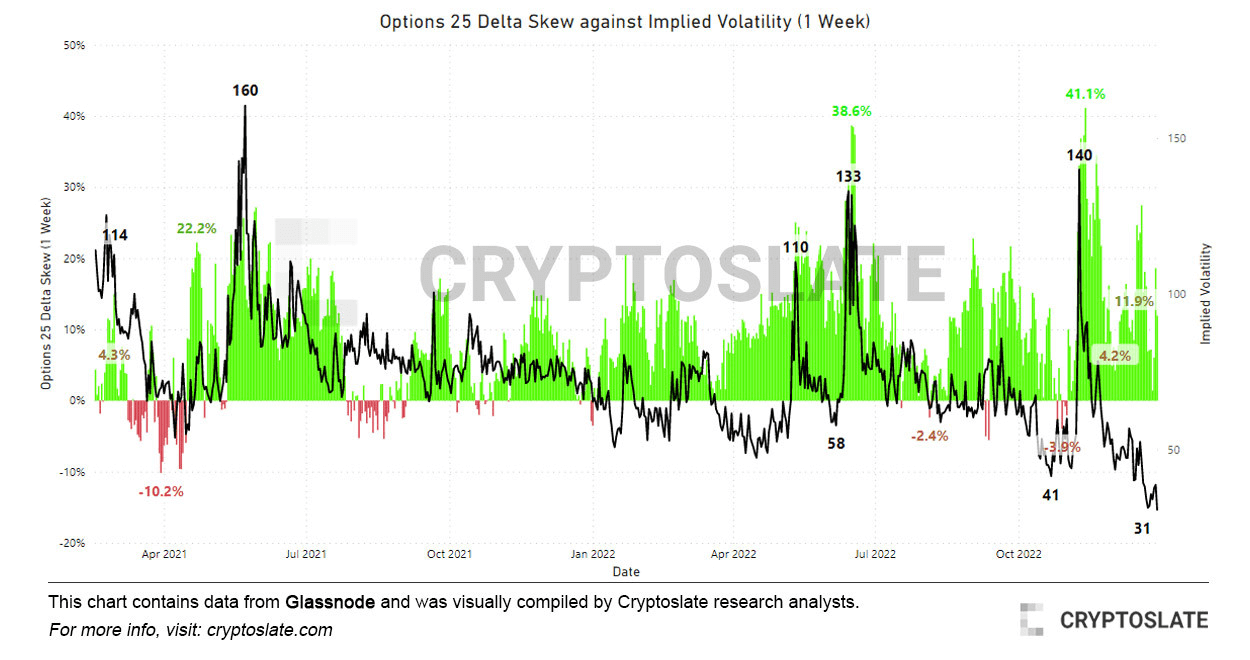 Research: Implied volatility shows only sideways movements for Bitcoin
Research: Implied volatility shows only sideways movements for Bitcoin Research: Implied volatility shows only sideways movements for Bitcoin
Bitcoin's implied volatility currently stands at a two-year low and shows that the derivatives market sees no major price movements in the near future.

Cover art/illustration via CryptoSlate. Image includes combined content which may include AI-generated content.
The crypto derivatives market has grown so big in the past few years that it can be used as an indicator of future price movements. Bitcoin options have captured the crypto industry and have quickly turned into mature products whose movements have the power to sway the rest of the market.
Just like in the traditional financial market, Bitcoin options grant their holders the right, but not the obligation, to buy BTC at a preset price at the contract’s expiration date. Options are usually priced using a metric called implied volatility (IV), which shows the market’s view of the likelihood of changes in a given security’s price.
Implied volatility (IV) is often used by investors to estimate future volatility in a security’s price. However, while IV can predict price swings, it can’t predict the direction in which the price will go. High implied volatility means there’s a high chance of a large price swing, while low IV means that the price of the underlying asset most likely won’t change.
As such, IV is considered a good proxy of market risk.
Looking at the implied volatility for Bitcoin shows that the market sees little risk in BTC.
Bitcoin’s implied volatility currently stands at a two-year low. The sharp drop in IV has historically followed aggressive spikes caused by black swan events — spikes were seen during the 2021 Defi Summer, the Terra collapse in June 2022, and the FTX downfall in November 2022.
However, the drop in implied volatility seen at the end of 2022 shows that the derivatives market sees no major price movements in the near future.

Comparing Bitcoin’s implied volatility with the options 25 delta skew further confirms this.
When applied to options contracts, skew measures the implied volatility between different strike prices with the same expiration. Put simply, it presents the ratio between put and call options. Delta is a measure of change in an option’s price resulting from a change in the underlying security.
The 25 delta skew looks at puts with a delta of -25% and calls with a delta of 25%, netted off to arrive at a data point. A 25-delta put skew of -25% means that the put option costs 25% less than the spot price of the underlying asset, and vice versa.
The metric essentially measures how sensitive an option’s price is to changes in Bitcoin’s spot price. Data analyzed by CryptoSlate shows that the premium for put options has come down from extreme levels recorded in November and June. Spikes in the 25 delta skew are usually a solid gauge for bear markets as they correlate with extreme bouts of price volatility.
December brought on a sharp drop in the 25-delta skew, which saw a slight increase in the first few days of 2023. Just like the drop in implied volatility, this indicates a much calmer market in the days and weeks to come.



 Farside Investors
Farside Investors 


 CoinGlass
CoinGlass 




























































































